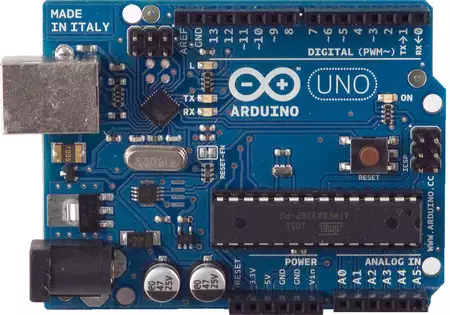Introduction to Arduino
Contents
- About Arduino
- What Can You Do With an Arduino?
- What components do you need to get started with Arduino?
- References
About Arduino
Contents
- About Arduino
- What Can You Do With an Arduino?
- What components do you need to get started with Arduino?
- References
About Arduino
Arduino is an open-source electronics prototyping platform based on flexible, easy-to use hardware and software. It’s intended for artists, designers, hobbyists, and anyone interested in creating interactive objects or environments.
Arduino can sense the environment by receiving input from a variety of sensors and can affect its surroundings by controlling lights, motors, and other actuators. The microcontroller on the board is programmed using the Arduino programming language and the Arduino Development Environment. Arduino projects can be stand-alone, or they can communicate with software running on a computer.

There are plenty of other microcontrollers available. So you may be asking, why choose the Arduino? Arduino really simplifies the process of building projects on a microcontroller making it a great platform for amateurs. You can easily start working on one with no previous electronics experience.
That is what this Arduino guide is about.
In addition to Arduino’s simplicity, it is also inexpensive, cross-platform and open source. The Arduino is based on Atmel’s ATMEGA8 and ATMEGA168 microcontrollers. The plans for the modules are published under a Creative Commons license, so experienced hobbyists and professionals can make their own version of the Arduino, extending it and improving it.
What Can You Do With an Arduino?
There is a lot you can do with an Arduino. An Arduino can basically do anything by interfacing sensors with a computer. This would allow you to take any sensor and have any action applied with the readings. For example (in one of our projects) we will read the level of light in a room and adjust an LED’s brightness to react based on that input. This of course is a simple example of what you can do with an Arduino. A more complicated example would be to read from multiple sensors and use that data to affect other outputs. Think of the possibility of wiring your house with all sorts of different sensors (photocells, oxygen sensors, thermometers) and having it adjust your blinds, air conditioner and furnace and make your house a more comfortable place.
Hackers have used Arduinos to create some amazing electronics projects. Things like:
- Robots
- Breathalyzers
- Remote controlled cars
- 3d printers
- Video games
- Home automation systems
- And much more.
What components do you need to get started with Arduino?
To start to experiment with Arduino, there is a set of common components. All these components can be purchased for a relatively small amount of money. This listing should be enough to give you a good understanding of basic electronics and have enough components to build some pretty cool projects using this or any other Arduino guide.
- Arduino Uno Microcontroller
- USB A-B Cable (same as your printer takes)
- Jumper Wires
- Microswitches
- Breadboard
- Resistors (1K-Ohm to 10K-Ohm)
- LEDs
